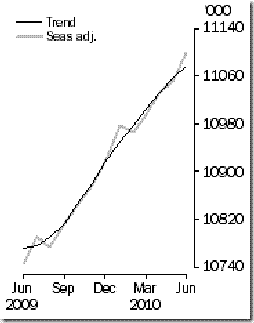In a post yesterday, Is Australia's trade position as good as it seems?, I wondered about the real strength of the Australian trade position. I may be right, but in the meantime growth continues.
The employment figures released yesterday by the Australian Bureau of Statistics were remarkably strong. The graph from the ABS gives a good visual picture of the trend.
The graph from the ABS gives a good visual picture of the trend.
David Uren in the Australian has a useful analysis of the numbers. Just to quote one part:
Western Australia generated half the new jobs last month and is regaining the role it had from 2005 to 2007 as the leading economic performer, with unemployment in that state now down to 4 per cent, a full percentage point drop since February.
Over the past three months, Western Australia and Queensland have led the employment growth, with more than 30,000 jobs created in each state, against just over 20,000 in NSW and Victoria.
Ultimately, jobs created are reflected in population numbers. Given the relative size of the state populations, an increase of 30,000 jobs in WA (population 2,270,276) as compared to 20,000 in NSW (population 7,191,500) and Victoria (population 5,496,408) is striking.
It takes time for economic shifts of this type to be fully reflected in population shifts. Initial increases in one type of employment are followed by other types. In legal services, for example, Perth lagged for some time because work stayed with the big eastern state firms. However, by August 2007, increases in remuneration in Perth were leading the nation. Actual amounts paid were still behind Sydney and Melbourne, but the gap was closing.
Another example is skilled employment in supporting activities. As mining expands, so do engineering activities required to maintain the mines. With time, this creates a series of often small engineering firms making parts and servicing equipment. This leads to a further increase in activities required to service those firms themselves.
I am not saying anything profound here. I am just interested in patterns, something I discussed a little most recently in Australia's economic fragmentation.
In the WA case, we have job increases leading to population increases feeding further job increases. This puts WA in a very different class from some parts of NSW.
In the case of the NSW (New England) North Coast, the rapid growth in population from the start of the eighties was linked to life style - retirement, tourism, coastal living in general. Jobs followed this increase, but they were generally lower paid service jobs. The North Coast now has some of the poorest areas in Australia measured by average incomes, with some of the highest areas of welfare dependence in the country. The population is also older.
Within NSW, only the coal mining areas of the Hunter and Liverpool display anything approaching the WA pattern and for the same reasons. However, here the higher level jobs remain in Sydney, as indeed they do in Perth in the WA case.
Shifts in economic power are inevitably associated with shifts in political power. This was one of the things that made the debate over the resources super profits tax so interesting. The intent of the tax was to capture a greater share of mining company profits and then redistribute them to parts of the country not benefiting directly from the growth in mining. I am not sure that it was ever quite put that way, but that was the practical effect.
This is not the first time that this has happened in Australian history. Federation itself and the associated imposition of the tariff barriers that was part of the price of Federation redistributed incomes from the export sectors to import competing sectors.
If you look at the responses to the tax, WA as a state was most directly affected and responded most strongly. It wasn't just the mining tax, but also other financial issues including the treatment of GST.
Queensland, too, was directly affected, but here the state response was more muted and lagged. Unlike WA, Queensland has large population areas not directly associated with mining who could be expected to support the original proposals. It wasn't until on-ground protests from mining areas gathered strength that the Premier came out in somewhat belated opposition.
The position in NSW was different again. Here the population in the resource rich areas constitutes a very small part of the total state population. At no stage so, far as I am aware, did the NSW Premier express serious concerns, despite the implications for state revenues from mining royalties.The on-ground concerns were there, but had much less impact on this debate. However, they did help fuel the re-emergence of new state support.
None of this should be construed as a comment on the tax itself, simply an analysis of the responses.
One of the interesting things about the spread of economic literacy in Australia is that people are far more aware of the flow-on effects.
If you look at official Australian material over the first decades of the 20th century such as the year books, you will find lots of comment, of concern, about the rise of metro populations. You will also find recognition that this was associated with industrialisation and the tariff. However the various linkages weren't fully understood. It would be many years before the theory of customs unions would provide a solid theoretical framework to analyse the differential impact of Federation.
The fact that people now have more knowledge is a good thing, although it does complicate life for governments! Still, the on-ground effects of change do remain clouded. I will continue to watch developments with interest.









No comments:
Post a Comment